Understanding the Impact of Retinitis Pigmentosa in Children: A Comprehensive Guide for Parents
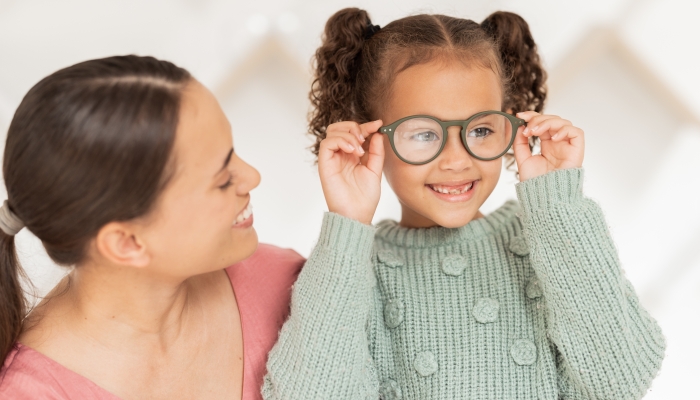
- Retinitis pigmentosa is an inherited disease that usually starts with a loss of peripheral vision and progresses to central vision with age.
- While there’s no cure for retinitis pigmentosa, some treatments exist that can improve symptoms of RP.
- Early intervention, peer support groups, and vision aids can all help a child with poor vision improve their ability to function independently.
- Your eye doctor may recommend experimental treatments like gene therapy for rapidly progressing vision loss.
Raising children naturally comes with many challenges, even under close-to-perfect circumstances. Parenting a child with retinitis pigmentosa (RP) presents an even more complex set of challenges.
While an eye specialist can help you manage medical treatments for your child, you’ll need to rely on other sources of support to help your child meet developmental milestones, function independently, and manage their emotions as they transition from childhood into early adulthood.
There’s currently no cure for retinitis pigmentosa in children, but there are some ways to slow the progression of the disease and help your child cope.
How Does Retinitis Pigmentosa Impact Child Development
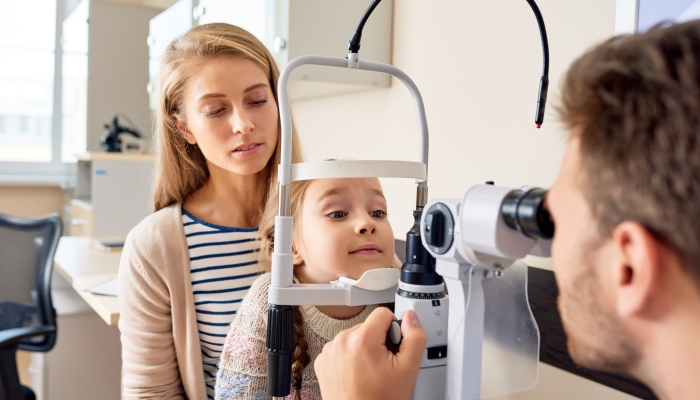
According to the World Health Organization11. World Health Organization. Blindness and vision impairment. World Health Organization. 2023;. https://www.who.int/news-room/fact-sheets/detail/blindness-and-visual-impairment#:~:text=Young%20children%20with,or%20care%20homes., children experiencing visual loss are at risk for motor delays, language and emotional problems, and higher rates of depression and anxiety.
While this is concerning, not all hope is lost. Parents of children with vision problems can change the trajectory of their children’s lives by enlisting the help of early intervention therapists, pediatricians, and social support groups.
Understanding the Emotional Toll
Children are highly influenced by their parents’ emotional responses. As vision loss occurs, parents can help their children build confidence by reminding them that they are capable of overcoming any challenges that are presented to them.
Research published by the Indiana Journal of Psychology22. Sturrock, B.. Treating depression in people with vision impairment. The Australian Psychological Society Limited. https://psychology.org.au/for-members/publications/inpsych/2018/feb/treating-depression-in-people-with-vision-impairm shows that acceptance-focused intervention is effective in helping people cope with most forms of chronic illness. Helping children accept their vision problems is the first step in helping them build confidence and feel like they can take control of their lives.
Meeting Milestones
Children with retinitis pigmentosa or other problems with poor vision may follow the same timeline for hitting major milestones as children without vision problems. Using an adjusted timeline can help you manage your expectations.
Retinitis Pigmentosa: What Parents Should Know

Retinitis pigmentosa (RP) is an inherited retinal disease that’s passed down through family members. It causes the light-sensitive cells of the retina to break down, which causes a progressive loss of vision. This vision loss usually begins in childhood and worsens throughout adulthood.
Symptoms and Progression
The first symptoms of retinitis pigmentosa include:
- Loss of color vision
- Sensitivity to bright light
- Difficulty adjusting to dim light
- Tunnel vision
- Loss of peripheral vision
- Poor night vision
Diagnosing RP in Children
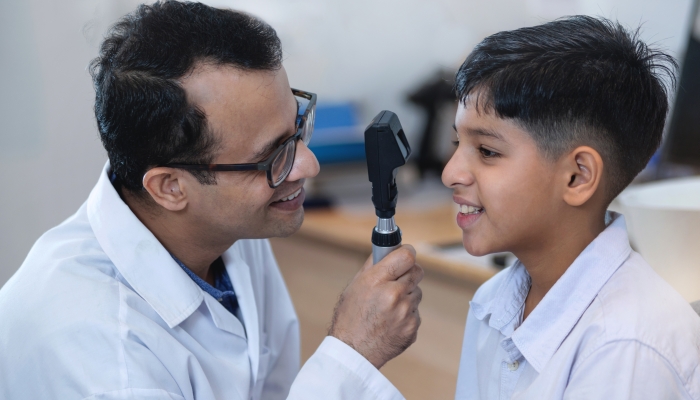
Getting an accurate diagnosis is important in creating a treatment plan for your child.
Clinical Examination
It can be difficult to diagnose vision problems in young children who cannot answer questions about their vision. However, your child’s doctor can easily check their peripheral vision and how the eyes react to light.
Parents’ observations can also help pediatricians understand a child’s vision problems. If you notice your child frequently bumps into things, has trouble finding items at night, or is sensitive to bright light, bring these symptoms up to your child’s eye doctor.
Electroretinogram (ERG)
An electroretinogram (ERG) can help to see how the retinal cells react to light. This type of test can help differentiate retinitis pigmentosa from other diseases.
An ERG is an outpatient procedure that takes about 90 minutes to complete. To perform the test, your child’s eye doctor will place numbing drops in their eye and may give them some medicine to help them relax. They will then use a tool to keep their eyes open during the test.
Genetic Testing and Counseling
Retinitis pigmentosa is one of many inherited eye diseases, meaning it it passed down from parent to child. If you have a family history of retinitis pigmentosa, a genetic counselor can talk to you about your risk of passing the trait to your children.
The National Human Genome Research Institute33. About Retinitis Pigmentosa. Genome.gov. 2013. https://www.genome.gov/Genetic-Disorders/Retinitis-Pigmentosa explains that if two parents carry the recessive retinitis pigmentosa gene, their child has a one in four chance of developing the disorder. If one parent has the dominant gene or suffers from the disease, the chance of the child developing symptomatic retinitis pigmentosa is one in two.
Management and Intervention for RP
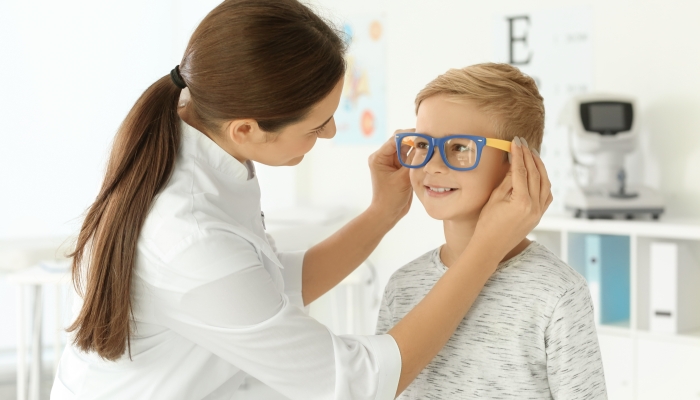
While there is no cure for retinitis pigmentosa, there are ways to help your child manage the disease.
Visual Aids
If your child has tunnel vision or poor night vision, they can use low vision aids like special glasses to improve their vision. Tools available to help with night blindness, loss of side vision, and poor color vision include:
- Bioptic telescopic glasses
- Prismatic reading glasses
- Reverse telescopic glasses
- Side-vision awareness glasses
- Tele-microscopic glasses
- Close circuit television (CCT) or digital magnifiers
- Custom-made optical systems
- Hand-held magnifiers
- Low vision magnifying reading glasses
Assistive Devices
In addition to using tools that help your child see, assistive devices can make a big difference in how well your child is able to function. Along with functional tools like canes and audio devices, try to find adaptive games and other enrichment activities that your child can participate in. Some common assistive devices include:
- Walking cane or smart cane
- Seeing eye dog
- Tactile tablet
- Alarms and audio devices
- Accessible cell phones
- Toys and games designed for vision-impaired children
Emerging Therapies and Clinical Trials
While there are currently no curative treatments for retinitis pigmentosa, there are several clinical trials that give people with RP hope for the future.
Gene Therapy
One of the most promising emerging therapies is gene therapy. Spark’s Therapeutics44. Retinitis Pigmentosa Research Advances. Foundation Fighting Blindness. 2023. https://www.fightingblindness.org/research/retinitis-pigmentosa-research-advances-3#:~:text=GenSight%2C%20Bionic%20Sight%2C%20and%20Nanoscope%20have%20each%20launched,conditions%20such%20as%20retinitis%20pigmentosa%20and%20Usher%20syndrome. has recently received approval for a gene therapy called LUXTURNA™ (voretigene neparvovec).
While it has not been used for retinitis pigmentosa yet, this unique gene therapy was able to restore vision for people suffering from Leber congenital amaurosis (LCA), a genetic condition that is similar to retinitis pigmentosa.
Retinal Implants
Retinal implants are another treatment that can improve vision in people with retinitis pigmentosa. For this treatment to work, people must have a healthy optic nerve, lateral visual cortex, and geniculate nucleus.
According to Clinical Neurophysiology55. Ayton, L. N., Barnes, N., Dagnelie, G., Fujikado, T., Goetz, G., Hornig, R., Jones, B. W., Muqit, M. M. K., Rathbun, D. L., Stingl, K., Weiland, J. D., & Petoe, M. A.. An update on retinal prostheses. Clinical Neurophysiology. 2019;131(6), 1383–1398. https://doi.org/10.1016/j.clinph.2019.11.029, 500 people were treated with retinal implants over the years 2005 and 2020 and had major improvements in their vision.
Vitamins and Antioxidants
If you are not ready to commit to a clinical trial of gene therapy or major surgery, you can try noninvasive treatments like adding Vitamin A and antioxidants to your child’s diet. Vitamin A is essential to the health of the eyes and photoreceptor cells, and antioxidant supplements may slow the progression of vision loss.
Make sure to speak to your child’s healthcare provider before adding supplements to your child’s diet, since too much Vitamin A can cause dizziness, vertigo, nausea, and vomiting.
Educational Adjustments
Whether your child has mild tunnel vision or complete blindness, schools and educators should be able to accommodate to their needs.
Individualized Education Program
Children with vision problems certainly have to overcome a lot of challenges as they head to school. A good Individualized Education Program (IEP) can help your child get the help and accommodations they need for success.
Parents can work with teachers and school administrators to create an IEP with both short and long-term goals for the child’s academic, social, and emotional success.
Supporting Your Child’s Journey

Besides showing unconditional love for your child, one of the best things you can do is become familiar with different support groups and resources for children with vision loss. Take advantage of any groups, assistance, resources, and educational programs that are available for your child.
Finding Peer Support
Government programs, school resources, and community centers are great places to find help for both you and your child with retinitis pigmentosa.
Foundation Fighting Blindness66. Welcome to the Foundation Chapters. Foundation Fighting Blindness. https://www.fightingblindness.org/chapters?msclkid=500a8874dd021e97c7f1ed60f450fec7&utm_source=bing&utm_medium=cpc&utm_campaign=SEM%7CFFB%7CNational%7CBrand%7CBR%7CBing&utm_term=foundation+for+blindness&utm_content=Main%7CPhrase has chapters all over the United States that help families connect with one another, raise money for research, and provide information to families dealing with vision loss.
Connecting with others not only helps you learn about new treatments and resources for your child, but it can also provide you with a sense of community and comfort as you navigate challenges and uncertainty about your child’s future.
The National Organization for Parents of Blind Children77. Welcome to the National Organization of Parents of Blind Children. National Federation of the Blind. https://nopbc.org is another great resource to stay connected with others, learn how to maximize your child’s independence and get updates about new clinical trials and research.
Financial Assistance
There is no denying that caring for a child with special needs can be a full-time job. Between early intervention, doctor appointments, and just managing the day-to-day needs of a child with vision problems, it can feel impossible to keep up with other responsibilities like work and household bills.
If you find that your family is in need of financial assistance while you commit more time to caring for your child, there are many resources88. Financial Assistance for Families. Childcare.gov. https://childcare.gov/consumer-education/financial-assistance-for-families#:~:text=The%20Supplemental%20Security%20Income%20%28SSI%29%20for%20Children%20program,resources%2C%20your%20child%20may%20be%20eligible%20for%20SSI. available. Some of these include:
- Supplemental Security Income for Children
- School Meal Programs
- Supplemental Nutrition Assistance Programs
- Temporary Assistance for Needy Families
- Medicaid
- Hospital Care Assurance Program
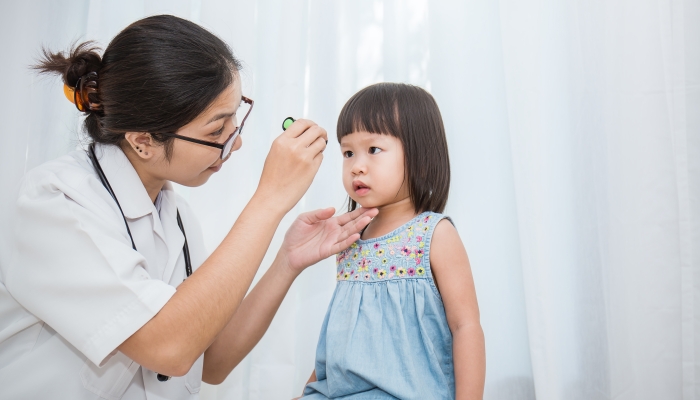
FAQs
How prevalent is retinitis pigmentosa in children globally, and are there regions where it’s more common?
Since retinitis pigmentosa is an inherited disease, it makes sense that it’s more common in some regions and ethnic groups than others. While there are nearly 70 genes responsible for retinitis pigmentosa, Hispanic Americans are most often carriers of the RP gene.
If you have a family history of vision problems or are worried that you may be a carrier, a genetic test can give you more information about your risk of passing on poor vision to your children.
How often should children with RP undergo eye examinations, and what should parents look out for between appointments?
The frequency of eye examinations for your child depends on the severity and progression of their disease. Since the vision of people with RP can decline at varying rates, it’s important to create an individualized care plan for your child.
If you notice that your child has behavior changes, light avoidance behaviors, trouble identifying objects, starts bumping into or tripping over things, or complains of headaches, take them to see their eye specialist.
Can my child with retinitis pigmentosa attend regular public school?
Even a legally blind child can attend public school, and they should be provided with resources and support that will help them succeed. If you choose to enroll your child in a regular public school as opposed to a special school for vision-impaired children, make sure their teachers understand what accommodations are necessary for your child.
References
- World Health Organization. (2023, August 10). Blindness and vision impairment. World Health Organization. https://www.who.int/news-room/fact-sheets/detail/blindness-and-visual-impairment#:~:text=Young%20children%20with,or%20care%20homes.
- Sturrock, B. (n.d.). Treating depression in people with vision impairment. The Australian Psychological Society Limited. https://psychology.org.au/for-members/publications/inpsych/2018/feb/treating-depression-in-people-with-vision-impairm
- About Retinitis Pigmentosa. Genome.gov. (2013, December 27). https://www.genome.gov/Genetic-Disorders/Retinitis-Pigmentosa
- Retinitis Pigmentosa Research Advances. Foundation Fighting Blindness. (2023, September 26). https://www.fightingblindness.org/research/retinitis-pigmentosa-research-advances-3#:~:text=GenSight%2C%20Bionic%20Sight%2C%20and%20Nanoscope%20have%20each%20launched,conditions%20such%20as%20retinitis%20pigmentosa%20and%20Usher%20syndrome.
- Ayton, L. N., Barnes, N., Dagnelie, G., Fujikado, T., Goetz, G., Hornig, R., Jones, B. W., Muqit, M. M. K., Rathbun, D. L., Stingl, K., Weiland, J. D., & Petoe, M. A. (2019). An update on retinal prostheses. Clinical Neurophysiology, 131(6), 1383–1398. https://doi.org/10.1016/j.clinph.2019.11.029
- Welcome to the Foundation Chapters. Foundation Fighting Blindness. (n.d.). https://www.fightingblindness.org/chapters?msclkid=500a8874dd021e97c7f1ed60f450fec7&utm_source=bing&utm_medium=cpc&utm_campaign=SEM%7CFFB%7CNational%7CBrand%7CBR%7CBing&utm_term=foundation+for+blindness&utm_content=Main%7CPhrase
- Welcome to the National Organization of Parents of Blind Children. National Federation of the Blind. (n.d.). https://nopbc.org
- Financial Assistance for Families. Childcare.gov. (n.d.). https://childcare.gov/consumer-education/financial-assistance-for-families#:~:text=The%20Supplemental%20Security%20Income%20%28SSI%29%20for%20Children%20program,resources%2C%20your%20child%20may%20be%20eligible%20for%20SSI.
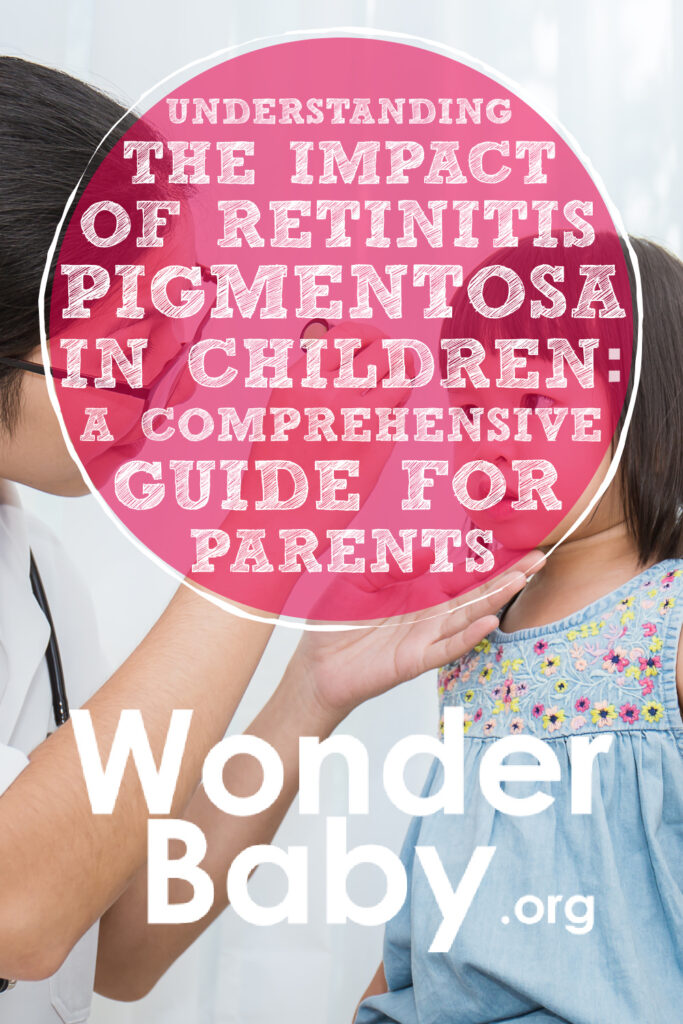
The information WonderBaby provides is not intended to be, and does not constitute, medical or other health advice or diagnosis and should not be used as such. Always consult with a qualified medical professional about your specific circumstances.
Related Posts

Visual Impairment
The Gift of Understanding: How a Young Child Helps His Blind Father Navigate Life
When a parent is blind, it’s natural for people to wonder how their sighted child will adapt. Will they struggle to understand their parent’s needs? Will they feel burdened by...

Braille and Literacy, Toys, Visual Impairment
24 Braille Toys for Kids Who are Blind
Everything from alphabet blocks to raised line coloring pages and activity books to puzzles to card and board games... and so much more! And it's all in braille ready for...

Tactile Arts and Crafts, Visual Impairment
Using Origami to Teach Blind and Low-Vision Students Basic Shapes
If, like me, you have wondered why it is important for young students to learn about shapes, here are just a few reasons. Teaching shapes in early education provides children...